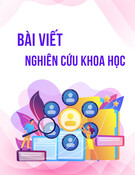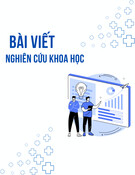2/e
P
P T
©2007 by the McGrawHill Companies, Inc. All rights reserved.
12
Culture:
Inside and Out
©2007 by the McGrawHill Companies, Inc. All rights reserved.
McGrawHill/Irwin
A Macro View of Culture
We learn culture through interaction with family, friends, and other members of society.
© Steve Mason/Getty Images
3
A Macro View of Culture
• What Is Culture?
◦
communally produced and shared model of reality that communicates how people are expected to behave, think, and feel
• How Do We Learn Culture?
Culture
◦
learning through a system of shared interaction with other people
4
Socialization
A Macro View of Culture
FIGURE 12.1 Macro View of Culture
5
A Macro View of Culture
• A Macro View of Culture
Communication
Direct and indirect
Rank, status, and age
Discussion and debate
6
Working together
Intercultural Writing and Speaking
• Writing from an International Perspective
Written greetings
Words to use
What to include
Speaking style
Listening
7
Nonverbal Behavior
A Macro View of Workforce Inclusion and Diversity
Diversity
◦ people from many different backgrounds and
Ethnocentrism
perspectives
◦ belief that one’s own culture is superior to
8
others
A Macro View of Workforce Inclusion and Diversity
• Race/Ethnicity
◦
inherited biological characteristics of a group such as skin color, facial features, and other physical variations
Race
◦
ethnic heritage and related cultural characteristics of a given group
9
Ethnicity
A Macro View of Workforce Inclusion and Diversity
• Race/Ethnicity (continued)
Hand gestures
Eye contact
Physical space
10
– Nonverbal Cultural Differences
A Macro View of Workforce Inclusion and Diversity
• Age
1. older phased out by younger, cheaper workers
2. younger not taken seriously
11
Stereotypes about age can damage productivity
A Macro View of Workforce Inclusion and Diversity
• Socioeconomics
• Gender
– Gender Differences
Communicating professionally
Communicating socially
12
Women and Men
A Macro View of Workforce Inclusion and Diversity
• Sexual
Orientation
• Physical
Disabilities
Workers with disabilities are an important part of a diverse workforce.
© Keith Brofsky/Getty Images
13
A Macro View of Workforce Inclusion and Diversity
• Practice Diversity
Race and ethnicity
Socioeconomics
Gender
Sexual orientation
14
Physical abilities
A Micro View of Organizational Culture
Corporate culture
◦
the way the organization operates, how it is structured, how members are expected to behave, and what the organization believes is important
Co-cultures
◦
like organizations, are smaller groups that exist within the larger culture and have their own values, beliefs, and codes for behavior
15
A Micro View of Organizational Culture
FIGURE 12.2 Micro View of Culture
16
Deep Organizational Culture
Deep culture
◦
17
the organization’s identity or personality, what it believes, perceives, and considers important
Deep Organizational Culture
• Values and Beliefs
◦
represent a set of shared principles defining what is important to members of an organization
Values
◦
feelings or opinions about what is right or true
18
Beliefs
Deep Organizational Culture
• Perspectives and Attitudes
◦
particular way of thinking about the world
Perspective
◦
learned inclination toward, or perception of, an idea, object, or person
19
Attitude
Deep Organizational Culture
• Vision
◦
organization’s purpose, mission, & future direction
20
Vision
Observable Organizational Culture
Observable culture
◦
21
involves the aspects of culture that can be seen, heard, or directly experienced by people
Observable Organizational Culture
Norms
◦
a series of behavior codes that guide acceptable conduct
Unconscious Norms
22
Institutional Rules
Observable Organizational Culture
Rites and Rituals
◦
various activities, ceremonies, and celebrations— particular performance interactions that convey organizational values
23
Observable Organizational Culture
Celebrations and ceremonies reinforce company values and can unite employees as a team.
24
© Ryan McVay/Getty Images
Observable Organizational Culture
Heroes
◦
organizational members who best demonstrate and symbolize company values
Lore
◦
involves stories or legends shared by members that reveal company history, appropriate conduct, and values
25
– How Lore Works
Observable Organizational Culture
• Lore (continued)
1. How does the company feel about rule breaking?
2. Is the boss human?
3. Will I get fired?
4. How does the company deal with obstacles?
26
– Themes of Organizational Lore
Observable Organizational Culture
• Practice Organizational Culture
Culture
• customer service • valuing employees
Values
• meeting project deadlines • observing dress codes
Norms and rules
• company picnics, retirement dinners, events
27
Rites and rituals
Observable Organizational Culture
• Practice Organizational Culture (continued)
Culture (continued)
• considered outstanding by other employees • well known in the company
Company hero
• stories told at meetings
during informal conversations on the company grapevine
28
Lore
Questions
29





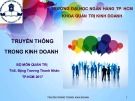
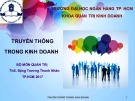
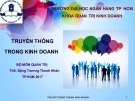
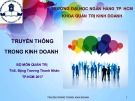

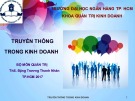
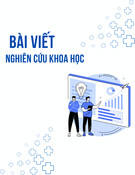
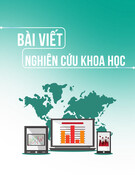
![Đề thi kết thúc học phần môn Truyền thông trong kinh doanh [năm học mới nhất]](https://cdn.tailieu.vn/images/document/thumbnail/2025/20251015/dilysstran/135x160/93281760499390.jpg)
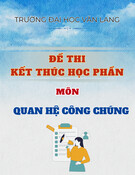
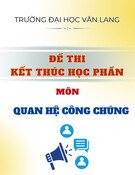
![Bài tập nhóm truyền thông marketing tích hợp [mới nhất]](https://cdn.tailieu.vn/images/document/thumbnail/2025/20250904/hakanami1502@gmail.com/135x160/90671756969236.jpg)
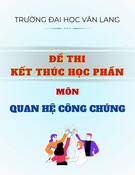
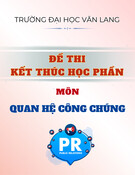
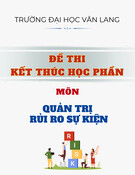


![Định vị doanh nghiệp: Bài thuyết trình [Mới nhất]](https://cdn.tailieu.vn/images/document/thumbnail/2025/20250813/vuthuhuyen1407/135x160/6261755072381.jpg)
